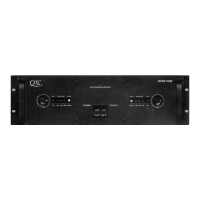27
c. Measure the voltage or place a scope probe on the lower driver emitter resistors, R25 or R26.
d. Replace the driver transistor if it has weak current (indicated by low voltage), its drive is low
(see above) or if its gain is low. If the driver shows equal or greater current, it is good and is
trying to overcome a weakness in the outputs or upper level driver.
e. To test the upper driver, short the upper driver Q3 or Q4 from collector to emitter (identify the
correct terminals first) while the amp is clipping. If there is no change, then the problem is the
upper outputs (inspect per above) or lower driver (note step d.). If, on the other hand, the limits
improve, then the upper driver is weak or the step circuit is defective.
f. Before testing the step circuit, examine the following values:
i. Positive circuit: R19, R20, R23, R57, D11, D12, Z15, Q23
ii. Negative circuit: R21, R22, R24, R58, D14, D15, Z16, Q22
g. If the values in step f are good, try shorting the 1.5k ohm resistor, R23 or R24. If this turns the
step on 10V earlier and corrects the weak limit, replace Q23 or Q22. If this produces no effect,
try replacing Q3 or Q4.
Excess Distortion
The circuit should show well below 0.1% distortion into 4 and 8 ohm loads, approaching the limit at 20kHz. Note:
the 3800 will show some excess distortion if the heat sink brackets are not firmly mounted to the heatsinks.
In the case of excess distortion, first distinguish between instability (fuzziness), ringing, which is momentary
instability after a transition, step distortion, crossover distortion (both often show ringing), or overall distortion.
1. Instability (fuzziness): see that section above.
2. Ringing
a. Usually indicates marginal instability, triggered after passing through the crossover or step. It
can indicate a problem in minor stability components (see that section above).
b. Also check the output filter, R56, L2, R49, R50, C5, and inner coil, R55 and L1.
c. Alternatively, the crossover or step may be larger than usual and need work (see below).
3. Crossover distortion
a. Possible causes of severe crossover distortion:
i. Shorted bias diode, D5 or D6
ii. Open circuit trace from lower voltage driver to lower outputs
b. Possible causes of moderate crossover distortion:
i. Out-of-spec bias diodes, D5 or D6 (voltage should be 0.55V each)
ii. Defective or shorted trimmer components, TR1 or R14
c. If you can’t get a notch on minimum setting
i. Check bias diodes, D5 and D6 and trimmer TR1 and R14
ii. Check for open base resistors, R15, R16, R17, R18, on output devices
d. If there is instability on one side,
i. Add a 0.015µF trimmer bypass capacitor around TR1
ii. Check or adjust the driver emitter capacitors, C9 and C10
4. Step distortion
a. Check the step circuit components (see list above, driver gain and step circuit) carefully and
note the exact output voltage where the step cuts in (both should match to 1V). After verifying
that all parts noted in the above lists are good, proceed to step b.
b. In the case of a “boxcar” glitch (rectangular deviation on distortion trace at 8 ohms),
i. Reduce the associated step capacitor, C7 or C8, by 50%
ii. Try replacing Q22 or Q23
iii. In severe cases, add a 470pF capacitor from collector to base of Q3 or Q4 as
necessary
c. In the case of a “fuzzy” glitch (usually 4 ohms or lower),
i. Check or increase the affected step speed-up capacitor, C7 or C8, by 25% to 50%.
d. In the case of a spike,
i. Check C7 and C8 (as above) or consult on possibility of 470pF (max) across the
collector to base junction of the upper driver transistor
e. If the step distortion is severe at 2 and 4 ohms, the step circuit is switching late; the following
are possible causes:
i. The 3.9V or 4.7V zener diode, Z15 or Z16, is reversed
ii. Q23 or Q22 is bad

